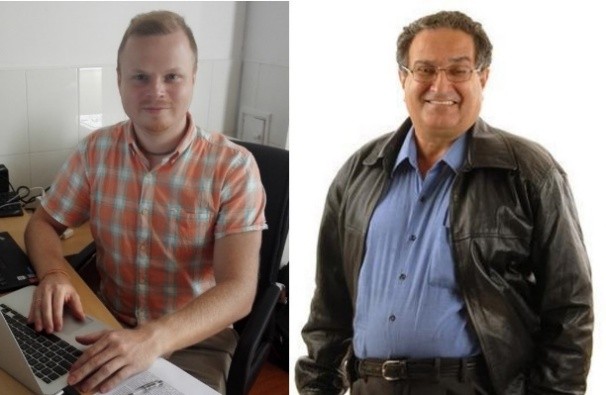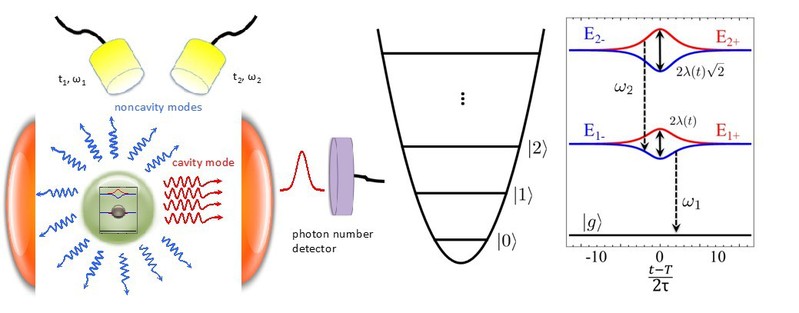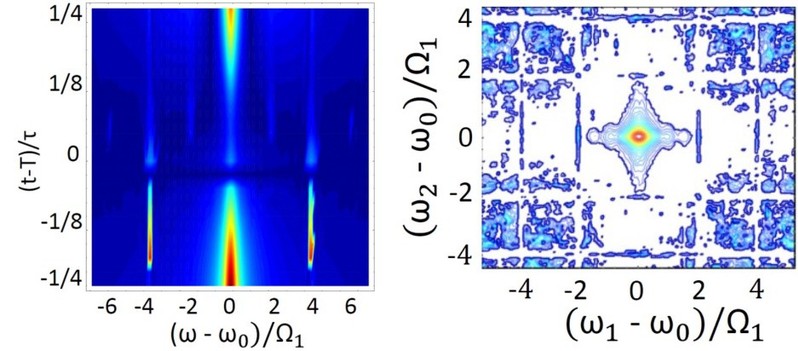Prof. Konstantin E. Dorfman of the State Key Laboratory of Precision Spectroscopy has made a progress in theoretical development of nonlinear spectroscopy with nonclassical light sources. The results of the study have been published in the article “Multidimensional photon correlation spectroscopy of cavity polaritons” in the International Journal: Proceedings of the National Academy of Sciences, PNAS.
The study presents a new multidimensional spectroscopy method for studies molecular polaritons in the optical cavities by measuring photon counting and photon correlation signals on the single photon level. In this work, East China Normal University is listed as the first affiliation. Prof. Konstantin Dorfman is listed as a first author, whereas both Prof. Dorfman and Prof. Shaul Mukamel of University of California Irvine are listed as corresponding authors..Dorfman has been introduced as a professor by ECNU and then be selected Young Thousand Talents Plan in 2017.These results can be applied in laser stabilization processes, ultrafast studies of chemical reactions and coherent control schemes.
The collaborative work between Profs. Konstantin Dorfman of ECNU and Prof. Shaul Mukamel of University of California, Irvine proposed a new techniques for studies of dynamics of molecules placed in the optical microcavities. Cavity quantum electrodynamics (QED) has been initiated by canonical work of Purcell in 1946. In 1963 Jaynes and Cummings worked out the theory of quantum radiation applying it to the beam maser. Later Haroche and Kleppner in 1980s developed a complete cavity QED framework for light-matter interactions inside optical cavities which lead to the Nobel Prize in Physics in 2012. Atomic states dressed by cavity electromagnetic radiation have been widely used since then in various areas of quantum, nonlinear optics, and laser cooling. Recently it has been shown that moleculescan also benefit from cavity QED physics by efficiently coupling their electronic and vibrational transitions to the cavity radiation modes. This in turn allow to manipulate chemical reaction rates and outcomes due to altering the potential energy surfaces via cavity polariton effects which gave rise to the new field of research of cavity spectroscopy and chemistry.
In the parallel course, a new type of nonlinear optical spectroscopy with nonclassical light has been developed by Dorfman and Mukamel and the results published in the Review of Modern Physics in 2016. Unlike coherent multidimensional techniques, which are based on carefully timed laser pulse sequences, incoherent techniques detect spontaneously emitted light, and the control knobs of such signals are based on single-photon gated detection. In this case the detection mode is a single photon counting measurement or a joint photon correlation measurement of the pair of photons. Thus in addition to the commonly used temporal and spectral information one may control photon statistics of the scattered light. These photon correlation signals are complementary to othercommonly multidimensional spectroscopy measurementssuch as magnetic resonance tomography commonly used in medical offices these days extended to single photon level. Thus, while the cavity QED studies and multidimensional measurements have been around for several decades, they have never been applied to the ultrafast single photon spectroscopic measurements. It is therefore an attractiveresearch topic for both theoretical and experimental physicists and chemists to investigate molecular dynamics at the single photon level and its applications.

Fig. 1 The first and corresponding author Prof. Konstantin Dorfman (left) with the article corresponding author Prof. Shaul Mukamel
The strong coupling is attributed to the enhanced density of radiation states inside the cavity governed by the Purcell effect, which results in the strong enhancement of the photon emission into the cavity modes. The joint atom plus photon states (polaritons) can be described by the Jaynes–Cummings model, which is a pillar of quantum optics. We shall use a generalized JC model, whereby the system–cavity field coupling is time dependent, which results in the time-dependent ladder of JC eigenstates. Their spontaneously emission can be detected by a time-and-frequency resolved(TF) photon gating obtained by consecutive spectral and temporal gates with individually controlled bandwidths. The practical implementation may involve ultrafast single photon upconversion schemes or terahertz scanning tunneling microscope. Optimizing the temporal and spectral resolutions is required when the field–matter coupling variation is faster than the inverse magnitude of the change of the coupling. We compare this gating with a simpler commonly used “physical spectrum” (PS) known since 1960s, which only uses a spectral gate characterized by a single parameter that controls both spectral and temporal resolution. We find that the TF gating can resolve a variety of dynamical features that are missed by the PS.

Fig. 2 (Left) Atom in the cavity emitting. Two TF-resolved detectors outside of the cavity register noncavity modes photon coincidence events.(Right) Fock states and time evolution of the dressed atom plus cavity (polariton) states of the JC subject to the coupling. Vertical black dashed lines represent transition between different ladder states captured by spectroscopic measurements.

Fig. 3 A 2D depiction of TF gated (Left): photon number vs time and frequency and (Right): photon coincidence vs two frequencies of the two photons, while the time gate parameters are fixed.
For slow cavity modulation, the temporal gate is not necessary, and the PSgating is adequate. However, rapid modulation requires separately controlled time gate when the product of temporal durationand spectral depth of the coupling is comparable with uncertainty limit, where PS fails and TF is required. The coincidence counting provides an additional information compared to the photon number. The 2D spectra mark the role of coherence between different dressed atom–cavity states that are governed by the coupling temporal profile, since the pair of photons can be generated from the superposition of two JC ladder states. It thus may provide the information on intramolecular couplings via strong cavity field, while its lineshapes govern information about fluctuating environment.Thus, the multidimensional spectroscopy techniques based on single photon counting and correlation measurements can be widely applied in the practical study of photochemistry and photophysics in the cavities.

